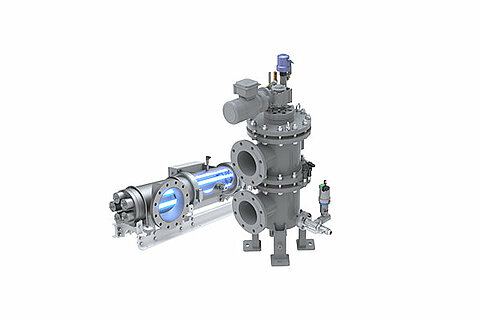Seawater, along with sources like rivers, lakes, and wells, is widely used in industry as intake water for critical processes. In Australia’s coastal cities, desalinated seawater is becoming essential for clean energy applications, including hydrogen production. Electrolyser-based hydrogen production requires substantial water resources, and effective filtration of desalinated seawater is crucial to ensure reliable, high-quality water for this process. HYDAC’s automatic back-flushing filters, inline filters, and screen basket filters are vital in treating desalinated seawater, enabling its use as cooling water, spray water, membrane feed, or process water, while preventing system disruptions and supporting sustainable hydrogen production.Â

Hydrogen production through electrolysers demands substantial water resources, with approximately 9-13 litres required per kilogram of hydrogen. For Australia’s coastal cities, desalination presents the most viable water source to support this process. Integrating advanced water treatment solutions, such as desalination, can ensure sustainable hydrogen production at scale, positioning Australia to lead in green energy.
Â
Protecting Systems with Comprehensive Water Filtration
Though particle contamination in industrial processes varies widely, there is an equally broad range of methods to remove them. Choosing the appropriate approach depends on understanding both the solid particle load and specific process data, along with setting clear filtration targets. Even with extensive knowledge and experience in separation technology, new challenges continuously arise, each demanding fresh solutions, as every application has its own unique requirements.
Â
Cooling Water

When cooling water is used, deposits often form on heat transfer surfaces, reducing heat efficiency and accelerating corrosion and wear. Over time, these build-ups can damage system components like measuring instruments and pipe fittings, leading to increased pressure loss within the system. This all contributes to higher maintenance demands and reduces overall cost-effectiveness. To prevent these issues in both fresh and recirculated water, our automatic, screen basket, and inline filters are applied for full-flow and offline filtration.
Â
Process Water

Process water is essential across various industries, serving roles like cooling, washing, boiler feed, or as ultrapure water. Sourced from rivers, lakes, seas, or underground, this water often contains particles, dissolved substances, and microorganisms that need thorough filtration. Our inline and back-flushing filters effectively remove these contaminants, enhancing water treatment efficiency and boosting system profitability.Â
Â
Waste Water

In municipal and industrial wastewater treatment facilities, drinking water is often used for general cleaning and maintenance tasks. However, treating water from the secondary clarifier can conserve drinking water. This discharge water is nearly clear in all weather conditions and has minimal suspended particles, although it’s not immediately suitable for service water use. Our industrial water filters remove undissolved organic and inorganic substances, preventing system clogs and supporting efficient wastewater management.
Â
Mussels Clog up Cooling Water Circuits

In recent years, invasive mussel species have been spreading rapidly in fresh, salt, and brackish waters. Two of the most problematic are the zebra mussel (Dreissena polymorpha) and its relative, the quagga mussel (Dreissena rostriformis bugensis). Originally from the Black Sea, these species have spread globally through ballast water and have now infiltrated industrial plants through natural water sources. Increased mussel presence creates significant system issues, as cleaning infested systems is labour-intensive and often requires a full shutdown.
Chemical treatments, like potassium chloride or hydrogen peroxide, are commonly used to kill mussels and larvae. While effective, these chemicals can leave unwanted residues, pose health risks, and are harsh on materials. In other words, chemical treatments work but are controversial, costly, and can carry unpredictable risks. Preventive measures, however, are more affordable and come with predictable costs.Â
Â
Protection against Small Invaders from the Sea
Coarse Protection for Vulnerable Systems

The AutoFilt® RF3 automatic back-flushing filter from HYDAC is designed to handle large clusters of mussels as well as some mussel larvae, maintaining a continuous nominal flow rate of up to 7,500 m³/h. During operation, water flows from the inside to the outside through wedge wire elements with a 50 µm filtration rating, providing systems with optimal protection against large mussel build-ups.
Â
Basket-based Protection against Mussel Larvae

To prevent the spread of mussels, it is crucial to filter out mussel larvae from the system. The AutoFilt® RF14 series offers superior filtration for mussel larvae, featuring a self-cleaning basket filter with finer filtration capabilities. With standard filtration ratings of 20 µm and 40 µm, approximately 95% of mussel larvae are effectively removed.Â
Â
Combination Solution with almost 100% Destruction of Mussel Larvae

Contact us for more information
Â
Â
3D Mixer,Machine Mixer 3D,3D Blender,3D Mixer Machine,rice powder mixer, cocoa flour mixer, sugar powder mixing equipment, food blender
Jiangyin Loongyi Machinery Co.,ltd , https://www.loongyi-asia.com
